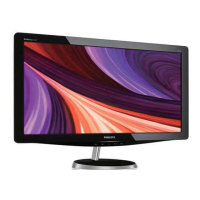
Do you have a question about the Philips 248C3LSB/00(AP) and is the answer not in the manual?
| Screen Size | 24 inches |
|---|---|
| Resolution | 1920 x 1080 |
| Panel Type | TN |
| Refresh Rate | 60 Hz |
| Brightness | 250 cd/m² |
| Contrast Ratio | 1000:1 |
| Aspect Ratio | 16:9 |
| Dynamic Contrast Ratio | 20, 000, 000:1 |
| USB Hub | No |
| Built-in Speakers | No |
| Power Consumption (Standby) | 0.5 W |
| Tilt | -5/20 degree |
| Swivel | No |
| Height Adjustment | No |
| Pivot | No |
| Response Time | 2 ms |
| Connectivity | VGA, DVI |
| Viewing Angle (H/V) | 170°/160° |
| Viewing Angles | 170° (H) / 160° (V) |
| VESA Mount Compatibility | 100 x 100 mm |
Precautions for handling the LCD module to prevent damage and ensure safety.
Step-by-step guide for connecting the monitor to a computer.
Addresses power LED status, no picture, and AUTO button issues.
Covers image centering, vibration, and vertical flicker problems.
Addresses horizontal flicker, blurriness, distortion, and static image problems.
Solutions for no sound, strong power light, and color dot issues.
Procedure to lock or unlock the OSD menu controls for user protection.
Steps to enter the monitor's factory service mode for advanced settings.
Details on navigating and using functions within the factory menu.
Procedure to activate the aging mode for testing monitor performance.
Explains Philips' policy regarding acceptable levels of pixel defects.
Steps for aligning the monitor using a color analyzer and pattern generator.
Steps to enter factory mode to perform color calibration.
Steps for adjusting white color temperature using CIE coordinates.
Information on the Easy Writer software used for firmware writing.
Details on the Q-EDID software for writing DDC information.
Steps for re-programming DDC data memory IC or main EEPROM.
Steps for setting up and using the PI-EDID software for firmware upgrades.
Instructions for connecting the monitor and mains cord for DDC operations.
Steps to set up the Philips-IMS EDID Tools program for DDC operations.
Instructions for opening the Q-EDID software interface as shown in figures.
Procedure for opening and selecting the specific DDC file for the monitor model.
Confirmation of successful DDC file loading as illustrated in the figure.
Steps to update and correct the serial number within the DDC data.
Instructions to execute the "RUN" command to write EDID and serial number.
Confirmation of successful EDID and serial number update as shown in the figure.
Process to read EDID and serial number to confirm successful update.
Instructions for installing the Port95nt.exe software and restarting the computer.
Steps to open the NOVATEK firmware upgrade tool.
Procedure for loading the firmware file into the upgrade tool.
Steps to initiate the firmware upgrade process by pressing the "Auto" button.
Confirmation message indicating a successful firmware upgrade.
Schematic of the LED driver IC, its power supply, and OVP circuit.
Steps and conditions for performing Perfect Tune II calibration and alignment.
Details on adjusting color temperature, including preset modes and CIE coordinates.
Identification of critical components and their corresponding part codes and availability.
Important warnings regarding ESD, handling, and tool usage during repair.
Cautions and procedures for handling, storing, and removing SMDs.
Guidelines for preventing oxidation and damage to SMDs during handling.
Methods for safely removing small surface-mounted devices using soldering tools.
Precautions to take when using soldering irons and tools for SMD removal.
Steps for correctly positioning and soldering SMDs onto the board.
Precautions for attaching SMDs, including temperature control and solder quantity.
Guidelines for using lead-free solder, tools, and techniques for repairs.
Specifies the types of lead-free solder alloys recommended for repairs.
Requirements for solder tools, including temperature capabilities and tip types.
Recommended temperature settings and precautions for solder tools.
Precautions for handling and storing lead-free BGA ICs to prevent moisture damage.
Procedures for removing and replacing BGA components, including heating and cleaning.
Flowchart to diagnose and troubleshoot bad brightness issues in the monitor.
Flowchart to diagnose and troubleshoot bad image quality problems.
Flowchart to diagnose and troubleshoot when the monitor has no display.
Flowchart to diagnose and troubleshoot when front control keys are not working.
Instructions for performing Hi-Pot testing on mains operated products.
Requirements for products undergoing safety tests, including Hi-Pot and Ground Continuity.
Procedures for connecting and performing safety tests like Hi-Pot and continuity.
Specifies test voltages, times, trip currents, and ramp times for safety tests.
Details the required equipment and connection setup for safety testing.
Requirements for recording and retaining safety test results for a specified period.
Suggestion to replace the entire module due to difficulty in separating bezel and CTRL BD.
Procedure for repairing the entire module when bezel or CTRL BD is non-functional.
Procedure to set input timing and enter factory mode for auto color calibration.
Steps to enable burn-in mode and confirm auto color function.
Final step to disable burn-in mode before exiting factory mode.
Instructions to turn on the monitor and enter user mode via the Menu button.
Procedure to select Setup, Reset, and Yes to restore factory settings.
Steps to perform auto adjustment after resetting the monitor.
